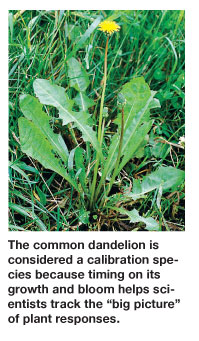 |
||||||||
 |
A Call for
Citizen-Scientists
 Citizen-scientists can help track the seasonal effects of climate change on Florida’s native plants and animals through new programs at the University of South Florida’s Ecological Research Area – or in their own yards and nearby parks with data compiled online.
Citizen-scientists can help track the seasonal effects of climate change on Florida’s native plants and animals through new programs at the University of South Florida’s Ecological Research Area – or in their own yards and nearby parks with data compiled online.
The USF site, the first in Florida, is ideal for analyzing the effects of hydrology, a key environmental factor in Florida, because it has both dry uplands and cypress wetlands. It also includes many kinds of Florida’s plants as well as 12 of Florida’s plant community types, 13 plant species that live only in Florida, three endangered species, three threatened ones, and three that are commercially exploited.
 By tracking events such as the first emergence of spring buds and the appearance of insects, land managers can better understand the effects that climate change is having on Florida’s native species. This revives a centuries-old tradition of monitoring cyclical events in the natural world and is part of the USA-National Phenology Network (USA-NPN).
By tracking events such as the first emergence of spring buds and the appearance of insects, land managers can better understand the effects that climate change is having on Florida’s native species. This revives a centuries-old tradition of monitoring cyclical events in the natural world and is part of the USA-National Phenology Network (USA-NPN).
“Because the timing of natural events is sensitive to weather and climate, they are an important living indicator of environmental change,” said George Kish, a USGS scientist and coordinator of the Southeastern Regional Phenology Network. “Scientists throughout Florida have been looking for ways like this that we can use to forecast how climate change will affect ecosystems and resources throughout Florida.”
Kish and Gordon Fox, a USF associate professor of plant ecology, worked together to establish the site in the USF Ecological Research Area. “The observations and data collected here will be valuable to resource managers working in similar ecosystems throughout the state as well as contributing to a larger view of how climate change may affect our natural resources,” said Fox.
Present-day phenology uses observations of cyclical events in the natural world such as migration, flowering and insect emergence to understand the effects of climate change on plants, animals and ecosystems. “For example, climate change models predict longer, more intense droughts in the southeastern United States,” said Kish. “These changes could significantly affect the plant communities the rest of the ecosystem depends on.”
“Scientists throughout Florida have been looking for ways like this that we can use to forecast how climate change will affect ecosystems and resources throughout Florida.” — George Kish, a USGS scientist |
Citizen scientists can help track climate change effects at the site by contacting Fox at gfox@cas.usf.edu. They can also record seasonal changes in plant and animal behavior in their own backyard and nearby parks or nature preserves for the National Phenology Network by registering at www.usanpn.org where they will find easy-to-use information on tracking nearly 200 species. These observations will eventually be analyzed against satellite-generated remote sensing data and weather data, then compared with detailed ecological studies.